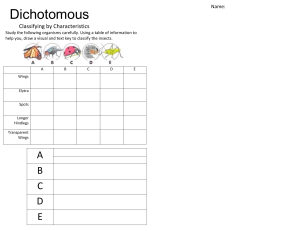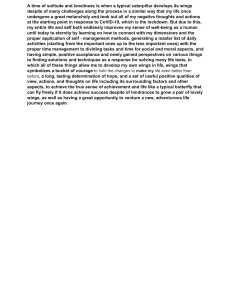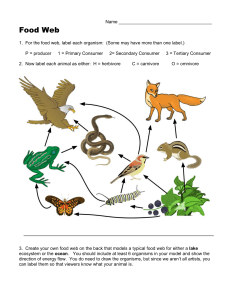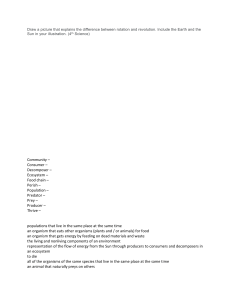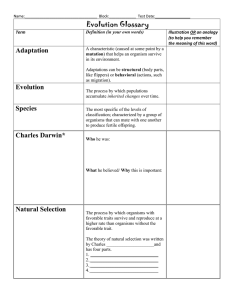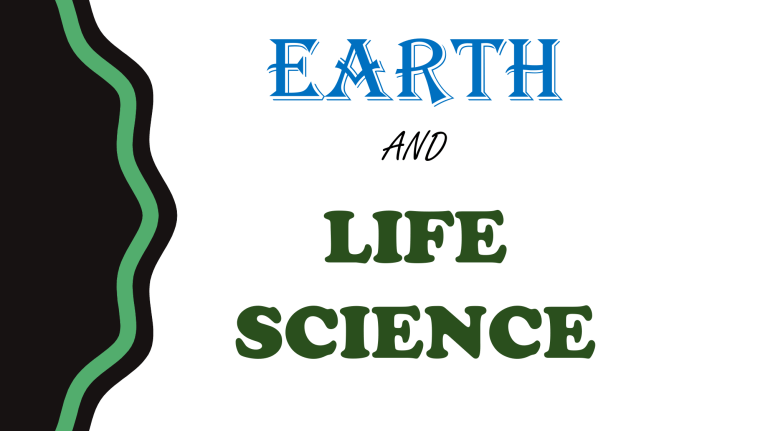
EARTH AND LIFE SCIENCE ATTENDANCE CLASS MONITOR STATE THE ABSENTEE UNIFYING THEMES OF LIFE THEMES OF LIFE - basic ideas that apply to all organisms - connects many things in the exploration of life 1. BIOLOGICAL SYSTEMS • SYSTEM – has properties/ functions based on the arrangement and interactions of its parts – together, the parts of our body enables us to move Example: Organ System • contraction of muscles attached to bones causes movement • blood vessels then supply these parts with oxygen and food 1. BIOLOGICAL SYSTEMS • Ecosystem – organisms in the ecosystem require a steady supply of certain chemicals to live plants obtain most of their necessary chemicals from the soil, water and air animals acquire most of the chemicals they need by eating plants or other animals chemicals are returned to the soil by bacteria and fungi that decompose the wastes and remains of 1. BIOLOGICAL SYSTEMS • Interaction of organisms with each other and with the nonliving environment put the system in ecosystem *The biological systems theme applies to all levels of life from the biosphere all the way down to the molecules in cells 2. THE CELLULAR BASIS OF LIFE • All organisms are made of cells • Levels of organization: - cell - tissue - organ - system - organism 2. THE CELLULAR BASIS OF LIFE • Most multicellularorganismshave cells that are specialized for different functions Muscle cells Contract and enable us to move Nerve cells Transmit impulses that control our muscles 2. THE CELLULAR BASIS OF LIFE • A multicellular organism’s development and survival are based on the functions and interactions of its many cells * The cellular basis of life is a theme you will encounter often as you explore the living world 3. STRUCTURE AND FUNCTION • The relationship between structure and function is apparent in the entire organism and the physiological systems that serve them • The structure determines function, function reflects structure – Technically, they are inseparable 3. STRUCTURE AND FUNCTION The aerodynamic shape of the bird’s wing Elliptical Wings (Fly catcher) High Aspect Ratio (Swallow) Elliptical Wings Birds that must maneuver in forested habitats have elliptical wings. Elliptical wings are slotted between primary feathers to prevent stalling at low speeds The small chickadee can change its course within 0.03 seconds. High-Aspect Ratio Birds that feed on the wing or make long migrations have high-speed wings. These wings sweep back and taper to a slender tip; this reduces turbulence. They are flat in section and lack wing-tip slotting. 3. STRUCTURE AND FUNCTION The aerodynamic shape of the bird’s wing Dynamic Soaring wings Albatrosses, gannets and other oceanic soaring birds have long, narrow wings. They have the highest aerodynamic efficiency of any design, but are less maneuverable. These birds exploit the highly reliable sea winds and air currents of different velocities. Dynamic Soaring Wings (Albatross) High- Lift Wings (Hawk) High-Lift Wings Vultures, hawks, eagles, owls and other birds of prey that carry heavy loads have wings with slotting, alulas and pronounced camber. This produces high lift at slow speed. Wings of these birds have an aspect ratio intermediate between elliptical wings and high aspect ratio wings. Many are land soarers; broad, slotted wings allow sensitive response for static 3. STRUCTURE AND FUNCTION • The structure of the bird’s bones contributes to the bird’s ability to fly Inside the bones, an open, honeycomblike structure provides great strength with little weight Birds have long extensions of nerve cells that control their flight muscles These fibers make it possible for the bird’s brain to coordinate flying movements 4. REPRODUCTION AND INHERITANCE • “Like begets like” – The offspring inherits units of information called genes from their parents • Genes: – Responsible resemblance for family – Made up of information-rich molecules called DNA 4. REPRODUCTION AND INHERITANCE • Each cell in the body contains a copy of all DNA that were inherited from our mother and father – When a cell divides, it copies its D N A and passes this genetic information on to each of the two cells it produces 4. REPRODUCTION AND INHERITANCE • In humans, an egg cell from the mother fuses with a sperm cell from the father – This results in a fertilized cell combination of D N A from both parents containing a – The inherited D N A directs the transformation of the fertilized egg into a person with his/her own eye color, facial features and other characteristics • *The inheritedinformation in the form of DNA enables organisms to produce their own kind 5. ENVIRONMENTAL INTERACTIONS • No organism is completely isolatedfrom its surroundings • As part of an ecosystem,each organism interacts continuously with its environment – The plants obtain water and nutrients from the soil, carbon dioxide from the air and energy from sunlight 5. ENVIRONMENTAL INTERACTIONS • The transfer of chemicals between organisms and their environments is a key process in any ecosystem – Breathing air, drinking water, eating food and getting rid of wastes are chemical exchanges with the environment 5. ENVIRONMENTAL INTERACTIONS • There is a constant sensing and responding to changes in the environment The specialized leaf of the Venus flytrap senses the light footsteps of a soon-tobe-digested fly The plant responses by rapidly folding the leaf together 5. ENVIRONMENTAL INTERACTIONS • There is a constant sensing and responding to changes in the environment The sun may cause organism to squint The bark of an approaching dog causes you to turn your head quickly 6. ENERGY AND LIFE • Moving, growing, reproducing and other activities of life require energy • Energy is obtained from chemical reactions – Sugars, fats and other “fuel-like” molecules in the food produce energy 6. ENERGY AND LIFE • Energy enters the ecosystem as sunlight Plants are producers that convert light energy to chemical energy stored in food Animals and other consumers obtain their energy in chemical form by eating Energy exist in the ecosystem as heat, which all organisms generate as they perform work 6. ENERGY AND LIFE • Because all organisms lose energy in the form of heat, an ecosystem cannot recycle energy *Life on Earth depends on a continuous supply of energy from the sun 7. REGULATION • Organisms have the ability to regulate their internal conditions The thermostat of the brain reacts whenever your body temperature varies slightly from 37◦C It then sends signals to the skin to produce sweat. Sweating helps cool the body Panting is another example of cooling mechanism. It causes moisture from the surface of the lungs to evaporate 7. REGULATION • The ability of mammals and birds to regulate body temperature is another example of homeostasis or “steady-state” • Different mechanisms enable organisms to regulate their internal environment despite changes in their external environment 8. EVOLUTION AND DIVERSITY • Explains changes in organisms over long periods of time – Adaptation allows life forms to acquire new characteristics in response to their environment through the process of natural selection Some animals make their coats lightened to facilitate hiding from predators 8. EVOLUTION AND DIVERSITY • The study of evolution is helping health professionals understand how disease-causing bacteria become resistant to antibiotic drugs • Environmental issues such as water and air pollution are changing how people think about their relationship with the biosphere • The population then evolves with its need for survival 8. EVOLUTION AND DIVERSITY Darker beetles are more likely to survive longer and reproduce, passing their genes on to more offsprings 8. EVOLUTION AND DIVERSITY • Great diversity exists among the three domains of living things: – Bacteria, Archea and Eukarya • • Evolution explains this diversity Charles Darwin and Alfred Wallace – Worked on the idea of evolution by natural selection 9. SCIENTIFIC INQUIRY • Involves asking questions about nature and then using observations or experiments to find possible answers to those questions By fitting a radio transmitter onto an Atlantic turtle, researchers can monitor its movement This can help researchers determine how large a nature preserve must be to support a population 9. SCIENTIFIC INQUIRY • Modern biology is changing humans’ everyday lives – New findings about the D N A affect medicine and agriculture – Research on the nervous system is improving the treatment of certain mental illnesses – The result of stem cell research, animal cloning, environmental issues, genetically modified crops or new ways to treat diseases show the impact of biology 10. SCIENCE, TECHNOLOGY AND SOCIETY • Technology applies scientific knowledge in new ways In 2013, Australia developers created a prototype for a bionic eye. It sends an image to a microchip in the brain, allowing the user to “see” the image 10. SCIENCE, TECHNOLOGY AND SOCIETY • Through science, humans learn about the solution to various problems • The scientificmethodis able to give directionand pace for every inquiry • Technologyproducedmachineryto lengthen the life of perishable goods
